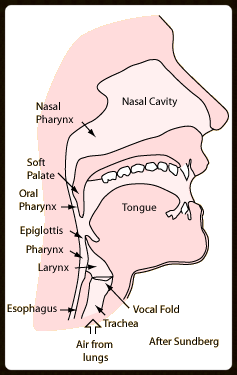how do we teach?
The vocal method we use helps to connect the different registers of the voice.
This often means finding or fine-tuning the lower register, then finding the upper register, then learning how to join them seemlessly together.
Then the voice is able to transition smoothly from lowest to the highest note - rather than break, crack or strain - the most common and frustrating problems - and you have the freedom to sing how you want.
The voice has one big quirk though… You cannot see what you are doing. Your vocal cords and larynx are hidden inside your neck. This is unlike almost every other skill you have ever learnt. It is therefore useful to know a few key things…
understanding your instrument
There are four main concepts that will help you understand your voice:
When you sing, you may feel the ‘resonance’ (or the vibration of the sound produced from your vocal cords) move up and down your vocal tract. The resonance feels like it moves up from the chest, into the mouth, behind the soft palate and nose, then further up in vertical direction in the head.
The vocal cords must be able to vibrate together AND adjust properly.
The larynx must stay in a mostly neutral position (i.e. not be lifted up, not be pushed down), and it must remain as stable as possible (i.e. not move up and down). If not, the tone of the voice will vary, and the ‘ease of production’ will vary.
Your breath must come from your diaphragm (and ribs). This gives the most control on exhalation, and also prevents any unwanted tension from your chest affecting your throat muscles. (It also looks better too!)
“What I like about this - and maybe it’s just your teaching method - but I feel like it’s very instinctive and I can just pick it up, rather than it being mental and then I have to think about it and translate the thought into action. The process itself takes you there, rather than you having to think.””
PROPER VOCAL FUNCTION
Vibrating cords
Basically, if the vocal cords are allowed to vibrate together in a flow of air they make sound.
adjusting cords
For good singing, this vibration must happen with the correct amount of vocal cord ‘adjustment’. The vocal cords cannot be too thick or too thin - they must be ‘just right’, throughout the entire range.
If they are too thick (usually in chest voice, or at the top of chest voice), there will be tension in the voice
If they are too thin (usually when moving into head voice), there will be cracks in the voice
neutral larynx
If the vocal cords are adjusting ok (not too thick or thin), but the larynx raises, then the tone might be consistent but it will be squeaky like a chipmunk or the Bee-Gees. (The Bee Gees are amazing but this should be an option!)
the result
If the cords are adjusted correctly, NOT squeezed then they can adjust in pitch in a controlled manner with even tone/timbre.
RESonance & vocal BRIDGES
As you sing, you may feel the vibration of your voice. As you sing higher or lower notes, you may feel this vibration move up and down your vocal tract.
What you are feeling is the ‘resonance’ - essentially the vibration of the sound bounce around inside the cavities of your mouth, throat, nose, and chest. This movement from one place to another - almost from one body part to another - is often called a ‘bridge'. A bridge is better than a break, as, by definition, it is joined up and is therefore better controlled.
“Feeling the resonance in the body can almost help singers VISUALISE their voice! (There’s nothing else to see - sound is invisible, and the larynx and vocal cords are covered by skin!)”
As a result of singing properly through a bridge, the resonance can often be felt to ascend up the vocal tract. It moves from the chest, into the mouth, behind the soft palate, and into the head. This helps singers being controlled, even, and connected, from bottom to top - without breaks, cracks, tension or noticeable changes in tone/timbre (unless stylistically desired).
'twang'
Providing there is no unwanted squeezing, you can raise or 'tilt' the larynx to add twang into a voice. This helps with projection but also helps the vocal cords adjust in pitch. (NB - Laryngeal tilt is not the same as laryngeal squeeze.)
To give the voice a stronger, fuller-sounding tone (as well as just twang), the larynx should be lowered back to a neutral position, with the tilt remaining but not the high larynx. And never any squeeze.
NOT 'OVER-TRAINED' or boring
Like a well-trained athlete, a healthy voice should be able to do more, for longer periods of time, with more stylistic options available, have more flexibility, more strength, have a more interesting tone, less pain, less wobbly, and ultimately be nicer to listen to.
Stylistic changes in tone - e.g. flips, yodels, falsetto, twang, distortion, etc. - can be added when required.
“Your vocal style should be a collection of your strengths, not your weaknesses.”









